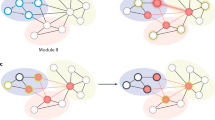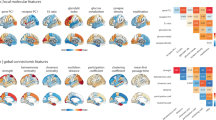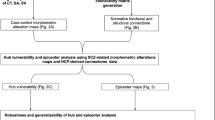Abstract
Macroscale white matter pathways are the infrastructure for large-scale communication in the human brain and a prerequisite for healthy brain function. Disruptions in the brain’s connectivity architecture play an important role in many psychiatric and neurological brain disorders. Here we show that connections important for global communication and network integration are particularly vulnerable to brain alterations across multiple brain disorders. We report on a cross-disorder connectome study comprising in total 1,033 patients and 1,154 matched controls across 8 psychiatric and 4 neurological disorders. We extracted disorder connectome fingerprints for each of these 12 disorders and combined them into a ‘cross-disorder disconnectivity involvement map’ describing the level of cross-disorder involvement of each white matter pathway of the human brain network. Network analysis revealed connections central to global network communication and integration to display high disturbance across disorders, suggesting a general cross-disorder involvement and the importance of these pathways in normal function.
This is a preview of subscription content, access via your institution
Access options
Access Nature and 54 other Nature Portfolio journals
Get Nature+, our best-value online-access subscription
$29.99 / 30 days
cancel any time
Subscribe to this journal
Receive 12 digital issues and online access to articles
$119.00 per year
only $9.92 per issue
Buy this article
- Purchase on Springer Link
- Instant access to full article PDF
Prices may be subject to local taxes which are calculated during checkout






Similar content being viewed by others
Data availability
The reference connectome dataset was based on data from the HCP, which are available from https://www.humanconnectome.org. The datasets ASD II, ASD III and ASD IV were obtained from the ABIDE II database and are available from http://fcon_1000.projects.nitrc.org/indi/abide/abide_II.html. The datasets Alzheimer’s disease II, MCI II and PTSD II were obtained from the ADNI and DOD ADNI database and are available from http://adni.loni.usc.edu. The dataset Schizophrenia III was obtained from the COBRE database and is available from https://fcon_1000.projects.nitrc.org/indi/retro/cobre.html. The datasets ADHD I, ALS, Alzheimer’s disease I, ASD I, Bipolar disorder, MCI I, MDD, Obesity, OCD, PLS, PTSD I, Schizophrenia I and Schizophrenia II are subject to specific data-sharing restrictions. To inquire about access to the restricted datasets, please contact the corresponding author.
Code availability
All codes used are available from the corresponding author on reasonable request.
References
Bullmore, E. & Sporns, O. The economy of brain network organization. Nat. Rev. Neurosci. 13, 336–349 (2012).
van den Heuvel, M. P., Kahn, R. S., Goñi, J. & Sporns, O. High-cost, high-capacity backbone for global brain communication. Proc. Natl Acad. Sci. USA 109, 11372–11377 (2012).
Baggio, H. C. et al. Rich club organization and cognitive performance in healthy older participants. J. Cogn. Neurosci. 27, 1801–1810 (2015).
Goodkind, M. et al. Identification of a common neurobiological substrate for mental illness. JAMA Psychiatry 72, 305–315 (2015).
Brainstorm Consortium et al. Analysis of shared heritability in common disorders of the brain. Science 360, eaap8757 (2018).
Nuyen, J. et al. Comorbidity was associated with neurologic and psychiatric diseases: a general practice-based controlled study. J. Clin. Epidemiol. 59, 1274–1284 (2006).
Crossley, N. A. et al. The hubs of the human connectome are generally implicated in the anatomy of brain disorders. Brain 137, 2382–2395 (2014).
Sha, Z. et al. Meta-connectomic analysis reveals commonly disrupted functional architectures in network modules and connectors across brain disorders. Cereb. Cortex 28, 4179–4194 (2018).
Fornito, A. & Bullmore, E. T. Connectomics: a new paradigm for understanding brain disease. Eur. Neuropsychopharmacol. 25, 733–748 (2015).
Zalesky, A., Fornito, A. & Bullmore, E. T. Network-based statistic: identifying differences in brain networks. NeuroImage 53, 1197–1207 (2010).
Glasser, M. F. et al. The minimal preprocessing pipelines for the Human Connectome Project. NeuroImage 80, 105–124 (2013).
Estrada, E. & Hatano, N. Communicability in complex networks. Phys. Rev. E 77, 036111 (2008).
van den Heuvel, M. P. & Sporns, O. Rich-club organization of the human connectome. J. Neurosci. 31, 15775–15786 (2011).
van den Heuvel, M. P., Bullmore, E. T. & Sporns, O. Comparative connectomics. Trends Cogn. Sci. 20, 345–361 (2016).
Ellison-Wright, I. & Bullmore, E. Meta-analysis of diffusion tensor imaging studies in schizophrenia. Schizophr. Res. 108, 3–10 (2009).
Bai, F. et al. Topologically convergent and divergent structural connectivity patterns between patients with remitted geriatric depression and amnestic mild cognitive impairment. J. Neurosci. 32, 4307–4318 (2012).
Griffa, A., Baumann, P. S., Thiran, J.-P. & Hagmann, P. Structural connectomics in brain diseases. NeuroImage 80, 515–526 (2013).
de Reus, M. A. & van den Heuvel, M. P. Estimating false positives and negatives in brain networks. NeuroImage 70, 402–409 (2013).
Betzel, R. F., Griffa, A., Hagmann, P. & Mišić, B. Distance-dependent consensus thresholds for generating group-representative structural brain networks. Netw. Neurosci. 3, 475–496 (2019).
Griffa, A. & van den Heuvel, M. P. Rich-club neurocircuitry: function, evolution and vulnerability. Dialogues Clin. Neurosci. 20, 121–132 (2018).
Hamilton, L. S. et al. Reduced white matter integrity in attention-deficit hyperactivity disorder. Neuroreport 19, 1705–1708 (2008).
Koldewyn, K. et al. Differences in the right inferior longitudinal fasciculus but no general disruption of white matter tracts in children with autism spectrum disorder. Proc. Natl Acad. Sci. USA 111, 1981–1986 (2014).
Peng, Z. et al. Brain structural abnormalities in obsessive–compulsive disorder: converging evidence from white matter and grey matter. Asian J. Psychiatry 5, 290–296 (2012).
Ashtari, M. et al. Disruption of white matter integrity in the inferior longitudinal fasciculus in adolescents with schizophrenia as revealed by fiber tractography. Arch. Gen. Psychiatry 64, 1270–1280 (2007).
van den Heuvel, M. P. et al. Abnormal rich club organization and functional brain dynamics in schizophrenia. JAMA Psychiatry 70, 783–792 (2013).
Grayson, D. S. et al. Structural and functional rich club organization of the brain in children and adults. PLoS One 9, e88297 (2014).
McColgan, P. et al. Selective vulnerability of rich club brain regions is an organizational principle of structural connectivity loss in Huntington’s disease. Brain 138, 3327–3344 (2015).
Fornito, A., Zalesky, A. & Breakspear, M. The connectomics of brain disorders. Nat. Rev. Neurosci. 16, 159–172 (2015).
Paulus, M. P. & Thompson, W. K. The challenges and opportunities of small effects: the new normal in academic psychiatry. JAMA Psychiatry 76, 353–354 (2019).
van den Heuvel, M. P., Scholtens, L. H., Feldman Barrett, L., Hilgetag, C. C. & de Reus, M. A. Bridging cytoarchitectonics and connectomics in human cerebral cortex. J. Neurosci. 35, 13943–13948 (2015).
de Haan, W., Mott, K., van Straaten, E. C. W., Scheltens, P. & Stam, C. J. Activity dependent degeneration explains hub vulnerability in Alzheimer’s disease. PLoS Comput. Biol. 8, e1002582 (2012).
Buckner, R. L. et al. Cortical hubs revealed by intrinsic functional connectivity: mapping, assessment of stability, and relation to Alzheimer’s disease. J. Neurosci. 29, 1860–1873 (2009).
Baker, S. T. E. et al. Developmental changes in brain network hub connectivity in late adolescence. J. Neurosci. 35, 9078–9087 (2015).
Dennis, E. L. et al. Development of the “rich club” in brain connectivity networks from 438 adolescents & adults aged 12 to 30. In Proc. IEEE International Symposium on Biomedical Imaging 624–627 (IEEE, 2013).
McTeague, L. M. et al. Identification of common neural circuit disruptions in cognitive control across psychiatric disorders. Am. J. Psychiatry 174, 676–685 (2017).
Sprooten, E. et al. Addressing reverse inference in psychiatric neuroimaging: meta-analyses of task-related brain activation in common mental disorders. Hum. Brain Mapp. 38, 1846–1864 (2016).
Elliott, M. L., Romer, A., Knodt, A. R. & Hariri, A. R. A connectome-wide functional signature of transdiagnostic risk for mental illness. Biol. Psychiatry 84, 452–459 (2018).
Cauda, F. et al. Brain structural alterations are distributed following functional, anatomic and genetic connectivity. Brain 141, 3211–3232 (2018).
Cross-Disorder Group of the Psychiatric Genomics Consortium et al.Genetic relationship between five psychiatric disorders estimated from genome-wide SNPs. Nat. Genet. 45, 984–994 (2013).
Doherty, J. L. & Owen, M. J. Genomic insights into the overlap between psychiatric disorders: implications for research and clinical practice. Genome Med. 6, 29 (2014).
Lee, P. H.et al. Partitioning heritability analysis reveals a shared genetic basis of brain anatomy and schizophrenia. Mol. Psychiatry 21, 1680–1689 (2016).
Sweeney, T. E., Haynes, W. A., Vallania, F., Ioannidis, J. P. & Khatri, P. Methods to increase reproducibility in differential gene expression via meta-analysis. Nucleic Acids Res. 45, e1 (2017).
Beaulieu, C. The basis of anisotropic water diffusion in the nervous system—a technical review. NMR Biomed. 15, 435–455 (2002).
van den Heuvel, M. P.et al. Comparison of diffusion tractography and tract-tracing measures of connectivity strength in rhesus macaque connectome. Hum. Brain Mapp. 36, 3064–3075 (2015).
Collin, G., Kahn, R. S., de Reus, M. A., Cahn, W. & van den Heuvel, M. P. Impaired rich club connectivity in unaffected siblings of schizophrenia patients. Schizophr. Bull. 40, 438–448 (2014).
Svatkova, A. et al. Physical exercise keeps the brain connected: biking increases white matter integrity in patients with schizophrenia and healthy controls. Schizophr. Bull. 41, 869–878 (2015).
Collin, G. et al. Brain network analysis reveals affected connectome structure in bipolar I disorder. Hum. Brain Mapp. 37, 122–134 (2016).
van Belle, J., van Hulst, B. M. & Durston, S. Developmental differences in intra-individual variability in children with ADHD and ASD. J. Child Psychol. Psychiatry 56, 1316–1326 (2015).
Repple, J. et al. A voxel-based diffusion tensor imaging study in unipolar and bipolar depression. Bipolar Disord. 19, 23–31 (2017).
Marqués-Iturria, I. et al. Affected connectivity organization of the reward system structure in obesity. NeuroImage 111, 100–106 (2015).
Reess, T. J. et al. Connectomics-based structural network alterations in obsessive–compulsive disorder. Transl. Psychiatry 6, e882 (2016).
Kennis, M. et al. Treatment outcome-related white matter differences in veterans with posttraumatic stress disorder. Neuropsychopharmacology 40, 2434–2442 (2015).
Serra, L. et al. Network-based substrate of cognitive reserve in Alzheimer’s disease. J. Alzheimers Dis. 55, 421–430 (2016).
van der Burgh, H. K. et al. Deep learning predictions of survival based on MRI in amyotrophic lateral sclerosis. NeuroImage Clin. 13, 361–369 (2016).
Cammoun, L. et al. Mapping the human connectome at multiple scales with diffusion spectrum MRI. J. Neurosci. Methods 203, 386–397 (2012).
Fischl, B. et al. Automatically parcellating the human cerebral cortex. Cereb. Cortex 14, 11–22 (2004).
Zalesky, A. et al. Whole-brain anatomical networks: does the choice of nodes matter? NeuroImage 50, 970–983 (2010).
Andersson, J. L. R. & Sotiropoulos, S. N. An integrated approach to correction for off-resonance effects and subject movement in diffusion MR imaging. NeuroImage 125, 1063–1078 (2016).
Andersson, J. L. R., Skare, S. & Ashburner, J. How to correct susceptibility distortions in spin-echo echo-planar images: application to diffusion tensor imaging. NeuroImage 20, 870–888 (2003).
Chang, L. C., Walker, L. & Pierpaoli, C. Informed RESTORE: a method for robust estimation of diffusion tensor from low redundancy datasets in the presence of physiological noise artifacts. Magn. Reson. Med. 68, 1654–1663 (2012).
Alexander, A. L., Lee, J. E., Lazar, M. & Field, A. S. Diffusion tensor imaging of the brain. Neurotherapeutics 4, 316–329 (2007).
Maier-Hein, K. H. et al. The challenge of mapping the human connectome based on diffusion tractography. Nat. Commun. 8, 1349 (2017).
Mori, S., Crain, B. J., Chacko, V. P. & van Zijl, P. C. M. Three-dimensional tracking of axonal projections in the brain by magnetic resonance imaging. Ann. Neurol. 45, 265–269 (1999).
Riley, J. W. et al. The American soldier: adjustment during army life. Am. Sociol. Rev. 14, 557 (1949).
van den Heuvel, M. et al. Proportional thresholding in resting-state fMRI functional connectivity networks and consequences for patient–control connectome studies: issues and recommendations. NeuroImage 152, 437–449 (2017).
Van Essen, D. C. et al. The Human Connectome Project: a data acquisition perspective. NeuroImage 62, 2222–2231 (2012).
Mori, S. et al. Stereotaxic white matter atlas based on diffusion tensor imaging in an ICBM template. NeuroImage 40, 570–582 (2008).
Yarkoni, T., Poldrack, R. A., Nichols, T. E., Van Essen, D. C. & Wager, T. D. Large-scale automated synthesis of human functional neuroimaging data. Nat. Methods 8, 665–670 (2011).
Willer, C. J., Li, Y. & Abecasis, G. R. METAL: fast and efficient meta-analysis of genomewide association scans. Bioinformatics 26, 2190–2191 (2010).
Margulies, D. S. et al. Situating the default-mode network along a principal gradient of macroscale cortical organization. Proc. Natl Acad. Sci. USA 113, 12574–12579 (2016).
Rubinov, M. & Sporns, O. Complex network measures of brain connectivity: uses and interpretations. NeuroImage 52, 1059–1069 (2010).
Irimia, A. & Van Horn, J. D. Systematic network lesioning reveals the core white matter scaffold of the human brain. Front. Hum. Neurosci. 8, 51 (2014).
Schmidt, R. et al. Correlation between structural and functional connectivity impairment in amyotrophic lateral sclerosis. Hum. Brain Mapp. 35, 4386–4395 (2014).
Mancini, M. et al. Network attack simulations in Alzheimer’s disease: the link between network tolerance and neurodegeneration. In 2016 IEEE 13th International Symposium on Biomedical Imaging (ISBI) 237–240 (IEEE, 2016).
Acknowledgements
M.P.v.d.H. was funded by an ALW open (ALWOP.179) and VIDI (452-16-015) grant from the Netherlands Organization for Scientific Research (NWO) and a Fellowship of MQ. The Muenster Depression Cohort was funded by the German Research Foundation (DFG; grant FOR2107 DA1151/5-1 and DA1151/5-2 to U.D.); SFB-TRR58 (projects C09 and Z02 to U.D.) and the Interdisciplinary Center for Clinical Research (IZKF) of the medical faculty of Münster (grant Dan3/012/17 to U.D.). K.K. was funded by the DFG (grant KO3744/7-1). N.E.M.v.H. was supported by the VIDI grant 452-11-014 from the NWO. M.H.J.H. received research support from The European Community’s Health Seventh Framework Programme (grant agreement no. F2-2008-222968), NARSAD Brain and Behavior Foundation (grant no. 20244) and The Netherlands Organization for Health Research and Development (MARIO grant no. 636100004). Data collection and sharing for this project were funded by the ADNI (National Institutes of Health (NIH) grant U01 AG024904) and Department of Defense ADNI (Department of Defense award number W81XWH-12-2-0012). ADNI is funded by the National Institute on Aging, the National Institute of Biomedical Imaging and Bioengineering, and through generous contributions from the following: AbbVie, Alzheimer’s Association; Alzheimer’s Drug Discovery Foundation; Araclon Biotech; BioClinica; Biogen; Bristol-Myers Squibb; CereSpir; Cogstate; Eisai; Elan Pharmaceuticals; Eli Lilly and Company; EuroImmun; F. Hoffmann-La Roche and its affiliated company Genentech; Fujirebio; GE Healthcare; IXICO; Janssen Alzheimer Immunotherapy Research & Development; Johnson & Johnson Pharmaceutical Research & Development; Lumosity; Lundbeck; Merck & Co.; Meso Scale Diagnostics; NeuroRx Research; Neurotrack Technologies; Novartis Pharmaceuticals Corporation; Pfizer; Piramal Imaging; Servier; Takeda Pharmaceutical Company; and Transition Therapeutics. The Canadian Institutes of Health Research is providing funds to support ADNI clinical sites in Canada. Private sector contributions are facilitated by the Foundation for the NIH (www.fnih.org). The grantee organization is the Northern California Institute for Research and Education, and the study is coordinated by the Alzheimer’s Therapeutic Research Institute at the University of Southern California (Los Angeles, CA, USA). ADNI data are disseminated by the Laboratory for Neuro Imaging at the University of Southern California. COBRE data were downloaded from the Collaborative Informatics and Neuroimaging Suite Data Exchange tool (COINS; http://coins.mrn.org/dx), and data collection was performed at the Mind Research Network and funded by the Center of Biomedical Research Excellence (COBRE) grant 5P20RR021938/P20GM103472 from the NIH to V. Calhoun. Data obtained from the SchizConnect database were funded by the NIMH cooperative agreement 1U01 MH097435. The database ABIDE II is primarily funded by NIMH 5R21MH107045. Data were provided in part by the HCP, WU-Minn Consortium (Principal Investigators: D. V. Essen and K. Ugurbil; 1U54MH091657) funded by the 16 NIH Institutes and Centers that support the NIH Blueprint for Neuroscience Research; and by the McDonnell Center for Systems Neuroscience at Washington University (St. Louis, MO, USA). The funders had no role in study design, data collection and analysis, decision to publish or preparation of the manuscript.
Author information
Authors and Affiliations
Consortia
Contributions
M.P.v.d.H. conceived the project. S.C.d.L. analysed the data. M.P.v.d.H. and S.C.d.L. wrote the manuscript. L.H.S. provided expertise and feedback on the manuscript. L.H.v.d.B., M.P.B., M.B., W.C., U.D., S.D., E.G., N.E.M.v.H, M.H.J.H., K.K., M.A.J., M.M., I.M.-I., S.M., R.A.O., T.J.R., J.R. and R.S.K. contributed data and provided feedback on the manuscript. Data used in preparation of this article were obtained from the ADNI database (adni.loni.usc.edu). As such, the investigators within the ADNI contributed to the design and implementation of ADNI and/or provided data but did not participate in the analysis or writing of this report. A complete list of the ADNI investigators can be found at: http://adni.loni.usc.edu/wp-content/uploads/how_to_apply/ADNI_Acknowledgement_List.pdf.
Corresponding author
Ethics declarations
Competing interests
L.H.v.d.B. serves on scientific advisory boards for Orion, Biogen and Cytokinetics; received an educational grant from Baxalta; serves on the editorial boards of Amyotrophic Lateral Sclerosis and Frontotemporal Degeneration and the Journal of Neurology, Neurosurgery, and Psychiatry; and receives research support from the Prinses Beatrix Spierfonds, the Netherlands ALS Foundation, The European Community’s Health Seventh Framework Programme (grant agreement no. 259867) and The Netherlands Organization for Health Research and Development (Vici Scheme, JPND (SOPHIA, STRENGTH, ALSCare)). All other authors declare no competing interests.
Additional information
Peer review information: Primary Handling Editor: Mary Elizabeth Sutherland.
Publisher’s note: Springer Nature remains neutral with regard to jurisdictional claims in published maps and institutional affiliations.
Supplementary information
Supplementary Information
Supplementary Methods 1–3, Supplementary Results 1–12, Supplementary Note, Supplementary References, Supplementary Figs. 1–12 and Supplementary Tables 1–6.
Rights and permissions
About this article
Cite this article
de Lange, S.C., Scholtens, L.H., Alzheimer’s Disease Neuroimaging Initiative. et al. Shared vulnerability for connectome alterations across psychiatric and neurological brain disorders. Nat Hum Behav 3, 988–998 (2019). https://doi.org/10.1038/s41562-019-0659-6
Received:
Accepted:
Published:
Issue Date:
DOI: https://doi.org/10.1038/s41562-019-0659-6
This article is cited by
-
Brain network communication: concepts, models and applications
Nature Reviews Neuroscience (2023)
-
White matter dysfunction in psychiatric disorders is associated with neurotransmitter and genetic profiles
Nature Mental Health (2023)
-
Influencing cognitive performance via social interactions: a novel therapeutic approach for brain disorders based on neuroanatomical mapping?
Molecular Psychiatry (2023)
-
DISCOVER-EEG: an open, fully automated EEG pipeline for biomarker discovery in clinical neuroscience
Scientific Data (2023)
-
Negative symptoms are associated with modularity and thalamic connectivity in schizophrenia
European Archives of Psychiatry and Clinical Neuroscience (2023)



